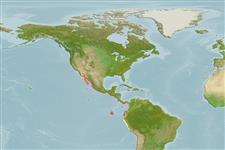>
Ovalentaria/misc (Various families in series Ovalentaria) >
Pomacentridae (Damselfishes) > Glyphisodontinae
Etymology: Abudefduf: Arabic, abu = father; this fish is the leader of the reef against other species (Ref. 45335).
More on author: Gill.
Environment: milieu / climate zone / depth range / distribution range
Ecologia
marinhas associadas(os) a recifes; não migratória; intervalo de profundidade 1 - 12 m (Ref. 5592). Tropical; 32°N - 18°S, 115°W - 73°W
Eastern Pacific: throughout the Gulf of California and from Bahía San Juanico, Baja California, Mexico to northern Peru, the Galapagos Islands and other offshore islands.
Tamanho / Peso / Idade
Maturity: Lm ? range ? - ? cm
Max length : 20.0 cm TL macho/indeterminado; (Ref. 55763); common length : 10.0 cm TL macho/indeterminado; (Ref. 55763)
Espinhos dorsais (total): 13; Raios dorsais (total): 12-13; Espinhos anais 2; Raios anais : 10 - 13. With black spot on pectoral fin base.
Adults inhabit rocky and coral reefs (Ref. 9334). Usually in large aggregations. These diurnal feeders feed on plankton at the surface or mid-water; also graze on benthic invertebrates and algae on the reef. Breed during early summer in the Gulf and continues throughout the summer until fall. This fish is a warm-water, stenothermal species. Juveniles of second year class have been observed cleaning schools of striped mullet, halfbeaks and needlefish (Ref. 5592). Oviparous, distinct pairing during breeding (Ref. 205). Eggs are demersal and adhere to the substrate (Ref. 205). Males guard and aerate the eggs (Ref. 205).
Ciclo de vida ou comportamento de acasalamento
Maturidade | Reprodução | Desova | Ovos | Fecundidade | Larvas
Oviparous, distinct pairing during breeding (Ref. 205). Eggs are demersal and adhere to the substrate (Ref. 205). Males guard and aerate the eggs (Ref. 205).
Allen, G.R., 1991. Damselfishes of the world. Mergus Publishers, Melle, Germany. 271 p. (Ref. 7247)
Status na Lista Vermelha da UICN (Ref. 130435)
Ameaça para os humanos
Harmless
Uso pelos humanos
Mais informação
ReferênciasAquaculturaPerfil para aquaculturaEstirpesGenéticaElectrophoresesHereditariedadeDoençasProcessamentoNutrientsConversão de massa
Ferramentas
Relatórios especiais
Baixar XML
Fontes da internet
Estimates based on models
Preferred temperature (Ref.
123201): 22.3 - 29.1, mean 26.4 °C (based on 257 cells).
Índice de diversidade filogenética (Ref.
82804): PD
50 = 0.5000 [Uniqueness, from 0.5 = low to 2.0 = high].
Bayesian length-weight: a=0.02188 (0.00932 - 0.05134), b=3.08 (2.89 - 3.27), in cm total length, based on LWR estimates for this Genus-body shape (Ref.
93245).
Nível Trófico (Ref.
69278): 3.0 ±0.32 se; based on food items.
Resiliência (Ref.
120179): médio(a), tempo mínimo de duplicação da população 1,4 - 4,4 anos (Preliminary K or Fecundity.).
Fishing Vulnerability (Ref.
59153): Low vulnerability (10 of 100).
Nutrients (Ref.
124155): Calcium = 74.3 [39.6, 117.5] mg/100g; Iron = 0.635 [0.383, 1.011] mg/100g; Protein = 18.5 [17.3, 19.5] %; Omega3 = 0.0977 [, ] g/100g; Selenium = 21.6 [12.5, 39.4] μg/100g; VitaminA = 76.8 [22.8, 242.4] μg/100g; Zinc = 1.42 [0.98, 2.04] mg/100g (wet weight);
